Why Every Trader Must Follow The Central Banks
Every developed nation has a central bank that has a core duty to ensure currency stability and that the interest rates of their nations are correctly set.
Contrary to what you might think, central banks want to inform the market about their intentions. They do this in order to ensure that price remains stable and under control and so as to avoid large volatile swings in price.
A volatile currency is bad for domestic businesses as they import and export goods, so central banks release information in order to assist traders in pricing their currency. This article will explain when every trader should follow central bank policy and give a brief run down of the key central banks from the major nations, with links to their websites.
Isn’t fundamental analysis pointless?
Perhaps you have heard the explanation that all the news is already priced into the chart. Well, that explanation is not only unhelpful, but it is also untrue.
When you think for a moment it becomes obvious too;
how can a central bank’s policy be priced into the market if the policy has only just been released?
Furthermore, it is worth reflecting why virtually every single institutional trading firm spends large sums of money to get economic data releases as fast as possible.
A Bloomberg terminal costs $2000 a month and is only available on a minimum 24 month contract. Following central bank policy is a very profitable activity for the savvy trader.
For example, when the Bank of Japan issued a quantitative easing programme in April 2013 it injected large sums of money into Japan’s banking system.
The consequence was that the Yen rapidly devalued and went from around 80.00 to 115.00 over the course of 14 months. You see this example shows two things.
Firstly, it shows that it took 14 months for price to reach the expected 115 level, so it can hardly be said to have been priced into the market.
Secondly, it shows the impact of a central bank’s monetary policy. If you had been tuned into that central bank event you had 14 months to profit from the information. In the chart below you can see how the Bank of Japan’s QE programme influenced the USD/JPY currency pair.
Isn’t Central Bank policy too difficult to follow?

You may be convinced that following central bank policy is a good idea, however, you may be unsure as to whether you can understand it without having a finance degree.
The good news is that although it may seem impenetrable at first and too complicated to grasp, all you need to focus on is what the central bank itself is focusing on.
Four key areas of central bank focus
The main areas that the bank focuses on revolve around a set of four economic indicators. They are as follows:
- Production (manufacturing data/housing/construction and services)
- Employment (people in work, full time vs part time and wage growth)
- Growth (GDP)
- Inflation
The two most important indicators are inflation and growth and these are areas for you to pay particular attention to.
Of these, the single most important area is inflation. Inflation concerns the costs of goods and services and all banks have a target rate or band that they would like their inflation level to be at.
It is usually around 2%, but each central bank will clearly state their own policy.
Four ways central banks can ensure price stability
Interest rates
To control inflation rising above the target level banks will raise interest rates. When a central bank increases interest rates the value of the currency goes up.
Conversely, if inflation is low the bank will cut it’s interest rates which will encourage people to spend their money and not save. When a central bank cuts their interest rates the value of the currency goes down.
If you look at the price chart below you can see that in July 2017 the Bank of Canada surprised the markets by raising interest rates. This was an unexpected surprise to the markets and, over the next two months, CAD gained over 500 points. Savvy traders could have made a very good profit from this decision.
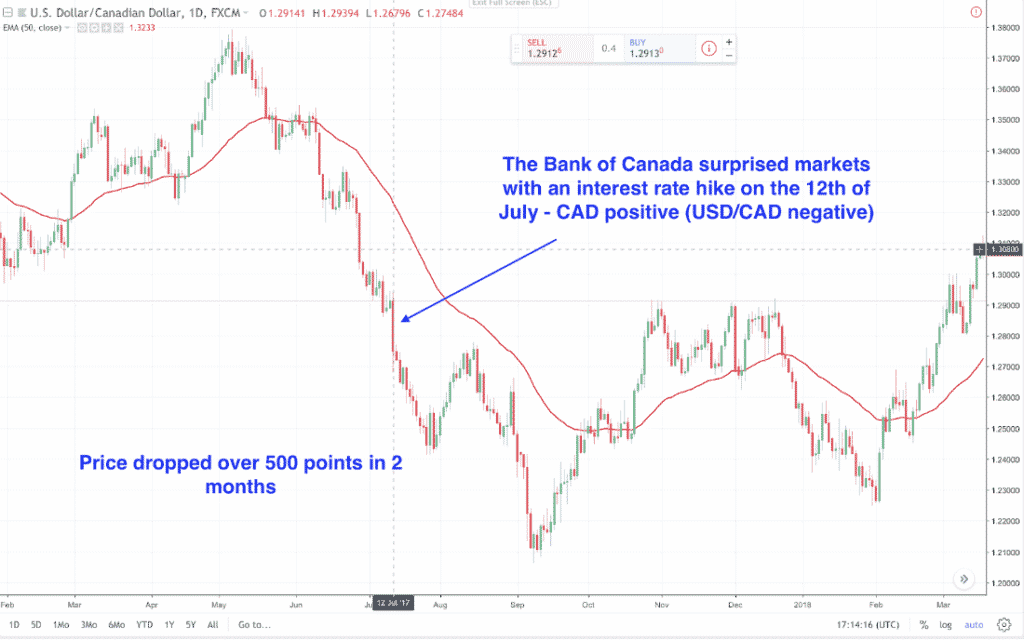
Quantitative easing
Known as QE, and widely used after the 2008 financial crisis, it is simply the printing of money. It stimulates growth and investment into a countries economy and simultaneously devalues a nations currency.
Any central bank about to embark on a QE programme will see it’s currency weaken. On the other hand, as a central bank unwinds their QE programme the pressure will be on for that nations currency to strengthen.

Central bank language
An altered phrase here or an indication of an outlook change can move currencies as traders react to any change in emphasis. A recent example is from Reserve Bank of New Zealand who announced in early August that their interest rates would now be ‘lower for longer’.
Markets instantly priced in a more dovish RBNZ and tuned in traders could have made another good profit.

Price Control
Central banks will sometimes try to keep a currency at a certain level. The most famous example is that of the Swiss National Bank that maintained a 1.2000 floor in the EUR/CHF pair for a number of years. More recently the Hong Kong Monetary Authority is defending the 7.85 peg agains the US dollar.
A word of caution, a nation cannot defend a level indefinitely and market fundamentals will eventually win through. A sober reminder of this is when in January 2015 the EUR/CHF peg was removed by the Swiss National Bank.
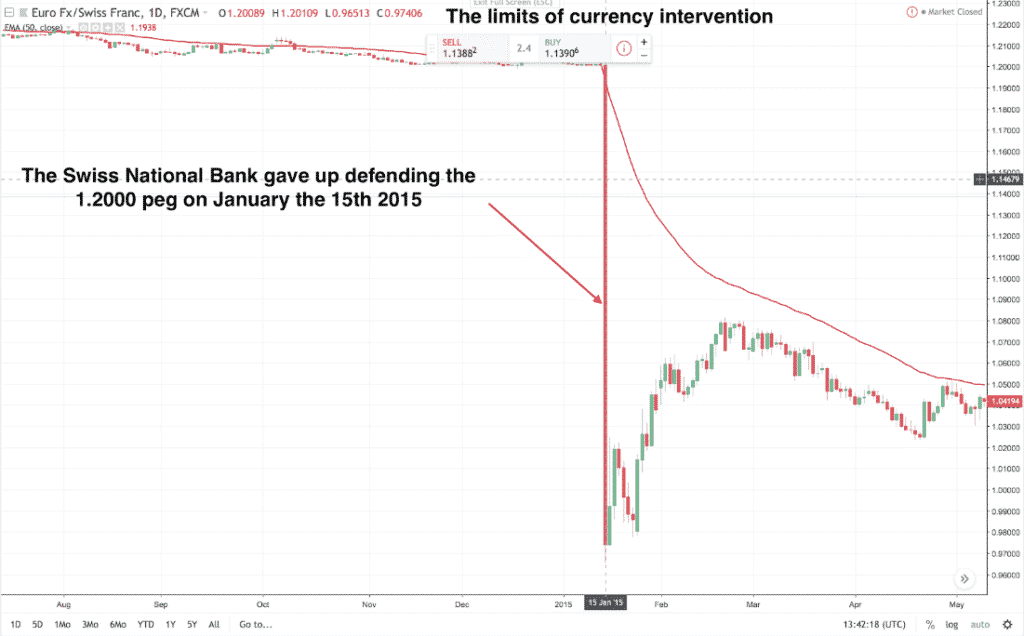
Through following the core messages from the central banks monetary’s policy you will not only know how to see which data releases are important, but you will also know how to profit from and understand the likely currency direction.
Furthermore, in the age of the internet, you can google the reaction to certain data announcements and look up what currency analysts are saying. Fundamental analysis works, is trusted and followed by nearly every single professional trader, so make it work for you.
In order to aid you in your pursuit of following the central bank’s this article will give a brief rundown of some of the world’s largest central banks and give links to their websites.
Eight of the world’s largest central banks

US Federal Reserve
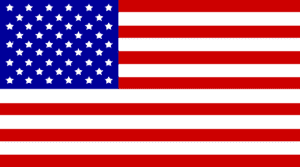
The Federal Reserve is the most important central bank in the world with the US dollar being the most traded currency in the world , comprising of around 70% of all transactions on a given day. It is clear why the Federal Reserve is a very closely watched bank which influences all other central banks across the world.
The US Federal Reserve website is here.
European Central Bank

The European Central Bank (abbreviated to the ECB) is the central bank of the 19 European Union countries which have adopted the euro. Their main task is to maintain price stability in the euro area and so preserve the purchasing power of the single currency. The European Central Bank was established on June 1st 1998 and is one of the world’s largest central banks.
Bank of England
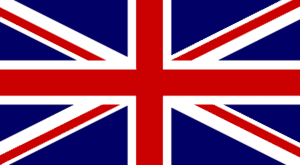
The blueprint for modern central banks emerged form the founding of the Bank of England (BOE). The BOE was created in 1694 n order to help fund a war against France. The Bank of England today is is run by the Monetary Policy Committee referred to as the MPC.
Bank of Canada
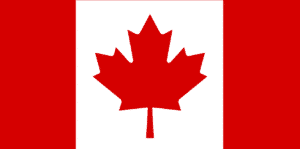
The Bank of Canada, although run by the Canadian government, is ultimately owned by the people of Canada. The Bank of Canada was built and has remained in Ottawa since its opening. It contributes an average of $1.7 billion in profit each year to the Canadian government.
Bank of Japan
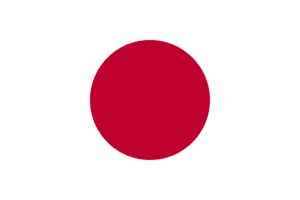
The bank of Japan is responsible for setting monetary policy for Japan. Japan is a very export dependent economy which means it wants a weaker currency in order to help it’s export market. It works hard to prevent excessive strength in the Yen and the Central Bank has, on occassions entered the market to artificially weaken its currency by selling the Yen against the USD and EUR.
The Bank of Japan’s website can be found here.
Swiss National Bank

The Swiss national Bank has two head offices; one in Zurich and one in Bern. The basic governing principle of the bank is to pursue a reliable monetary policy for the benefit of the Swiss economy and the Swiss people.
Reserve Bank of Australia

Their monetary Policy consists of a Governor, currently Philip Lowe, a deputy Governor and 6 independent members appointed by the Government. They meet 11 times a year, meeting on the 1st Tuesday of every month apart from in January.
Reserve Bank of New Zealand
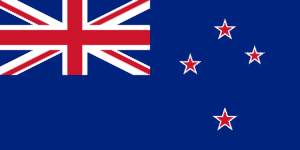
The Reserve Bank of New Zealand has just the one person who is a central Bank Governor. That Governor is ultimately responsible for making the decision on the country’s interest rate. It has a target rate of between 1-3%. The Reserve Bank’s primary function, as defined by the Reserve Bank of New Zealand Act 1989 is to provide “stability in the general level of prices.”[5] The Reserve Bank is responsible for independent management of monetary policy to maintain price stability. It releases Monetary Policy statements four times a year in each Quarter. Failure to meet inflation targets can mean dismissal of the Governor.
If You Enjoyed this article, please Give It a Share
About This Article
Author: Giles Coghlan
Sources of information and credits for this post include:
